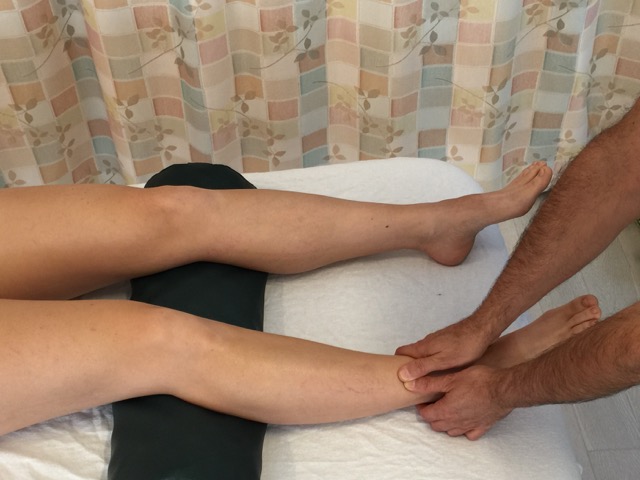Manual therapy treatment for an inversion ankle sprain:

Effleurage stroke over the anterior leg musculature from distal to proximal. Permission: Joseph E. Muscolino.
Manual therapy treatment for an acute inversion ankle sprain is primarily palliative in nature and aimed at decreasing swelling and inflammation and relieving associated muscle spasm that might be occurring to splint/stabilize the joint. Effleurage strokes and ice (cryotherapy) are used to decrease swelling/inflammation. Effleurage strokes should be gentle and directed from distal to proximal. Ice should be left on until the area is numb; then removed. Muscle splinting is likely in the eversion musculature, but is also likely throughout the entire lower extremity and even the contralateral lower extremity and low back because of the antalgic gait from the ankle sprain. Therefore, it is important to work these associated areas proactively to prevent other conditions from developing.
For a chronic inversion ankle sprain, the major goal is for the client/patient to strengthen the eversion musculature to compensate for the loss of lateral ligament integrity. The role of manual therapy is to work any muscular spasming and myofascial trigger points that might have developed as a result of the sprain. This can be done with any and all techniques with which you are comfortable. Even though the ankle joint will likely be hypermobile into inversion, it is important to assess (via motion palpation) the joints of the lower extremity for non-axial joint play motion (motion palpation) and perform joint mobilization (arthrofascial stretching) if compensatory hypomobilities are found.
Summary of Manual Therapy Treatment Protocol of Inversion Ankle Sprain
| Acute sprain: |
| 1. Gentle effleurage of the foot/ankle/leg from distal to proximal |
| 2. Ice |
| 3. Soft tissue manipulation to the eversion musculature |
| 4. Work the entire affected lower extremity, contralateral lower extremity, and low back |
| Chronic sprain: |
| 1. Work associated musculature for tightness and trigger points (soft tissue manipulation, moist heat, stretching) |
| 2. Mobilize (arthrofascially stretch) compensatory joint hypomobilities, if present |
| 3. Strengthen the eversion musculature |
Precautions/contraindications when treating a client with inversion ankle sprain:
Because an inversion ankle sprain results in tearing of ligamentous tissue, no stretches that would cause the injured ligaments to lengthen should be done until the ligament tissue has fully healed. Therefore stretching into inversion and likely plantarflexion are contraindicated, especially during the acute stage. During the acute stage, nothing should be done that would increase swelling and inflammation; therefore, any soft tissue manipulation should be gentle in force.


